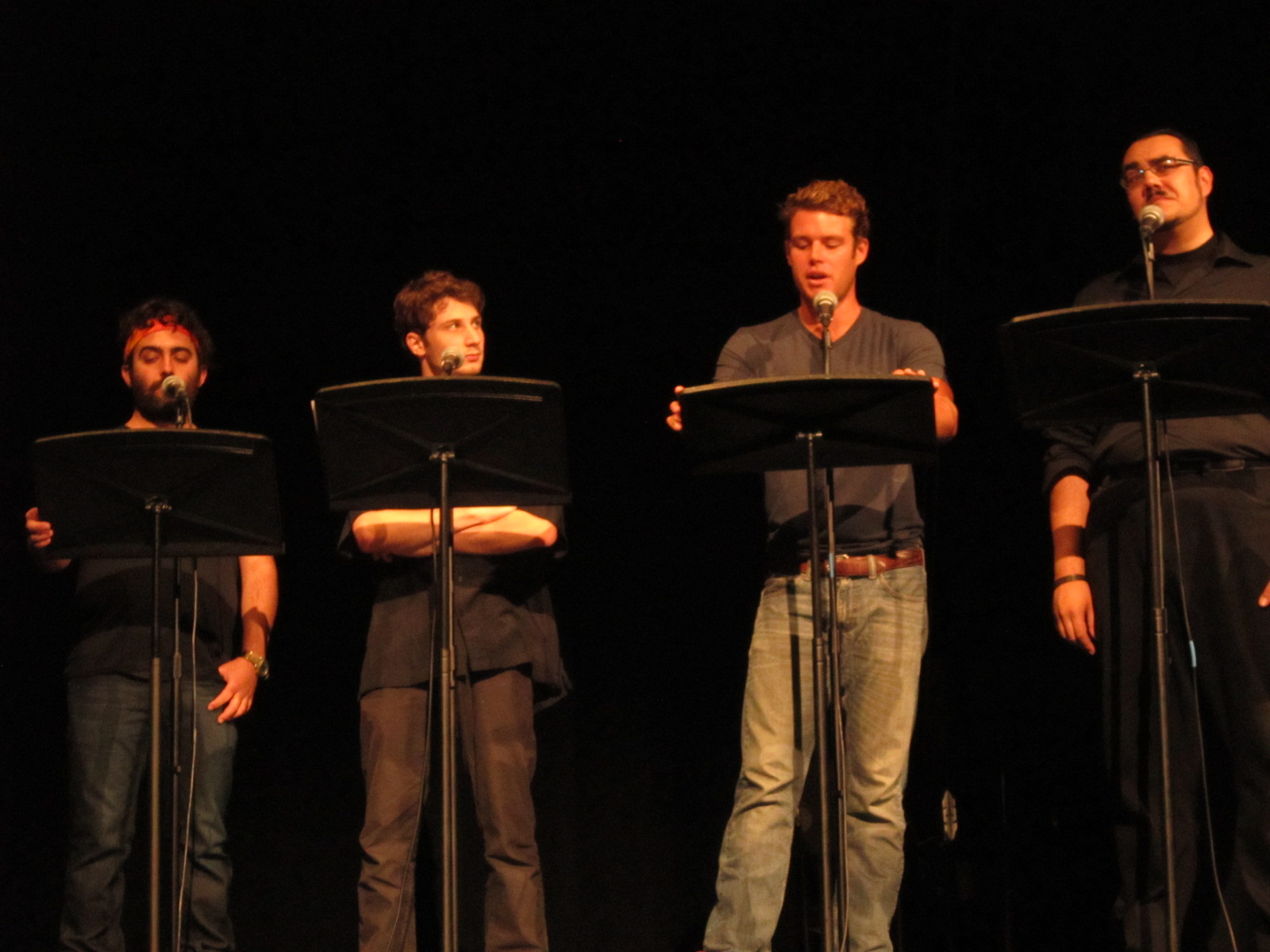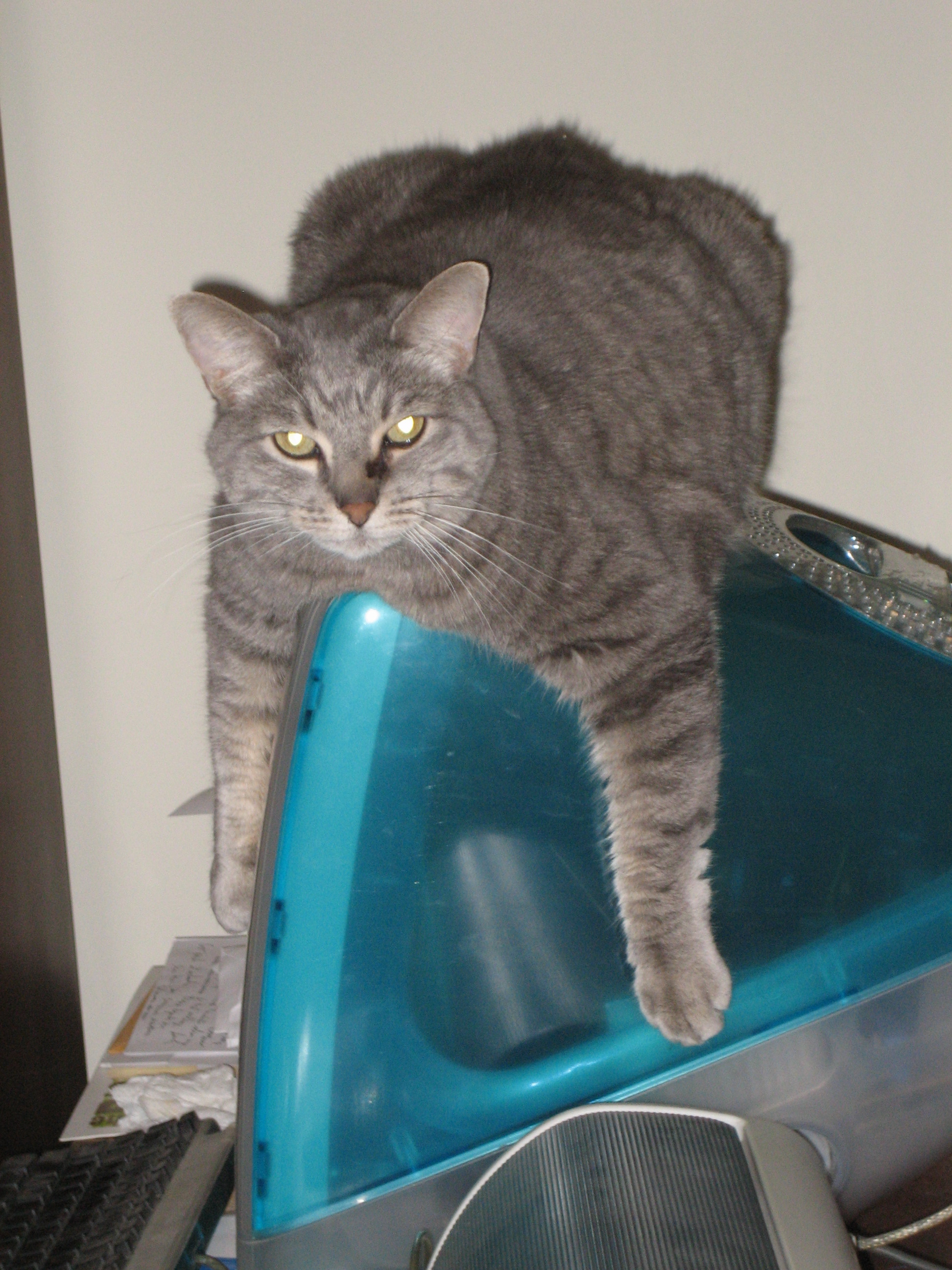 PLACE: Los Angeles County Museum of Art; Bing Auditorium
PLACE: Los Angeles County Museum of Art; Bing Auditorium
Photo: Copyright Linda Fry. All rights reserved. (Click on photo to see full picture. From left to right: Devin Falk, Joshua Grapes, Kyle Jones, and Robert Edward.
DATE/TIME: Saturday, October 11, 2014; 2:00 p.m.
S.A. Griffin did an extraordinary job at LACMA this morning in getting the cast prepared for the staged reading. I had never met half the cast, nor had they met each other, and the first task was to assign the parts. Unfortunately, Eric Morago had an emergency that required him to relinquish his role in today’s production, but I had had a gut feeling earlier this week that an understudy might be needed and I asked a recent CSULB graduate, Kyle Jones, to show up just in case. He ended up playing the role of the Poet, while Robert Edward took on the part of the Dealer. Devin Falk and Josh Grapes played the Hipsters, and Cheryl Fidelman joined in as the Girl. Eric Reed’s piano accompanied the recitation.
This event at LACMA grew out of a small exhibit focused on Venice, for which a mural painted on linen that had hung in the Venice post office for many years had been restored. The mural will return to home after the exhibit concludes, though the building is no longer a post office, but a movie production company headquarters. The mural itself is cited in Stuart Perkoff’s long poem, “Voices Heard in Venice,” which he composed during the same period in which he worked on “Round About Midnight.”
Originally, in terms of mounting this event, I had a peripheral role. I was only supposed to deliver an introductory talk, which I will include in this post. I only delivered about two-thirds of this introduction, however. (The Bing Auditorium was on a tight schedule, and I wanted Eric Reed and his company to have as much time to play as possible.) My role in this project changed radically two weeks ago when Mary Lenihan wrote me an e-mail and asked if I could find some new actors, since the group that had committed to do had taken on a new project. I spent a good portion of the past two weeks assembling the cast and discussing approaches to this staged reading with S.A. Griffin, who agreed to serve as director about a week ago. If the cast was unfamiliar with Perkoff’s poetry, it was crucial to have a director who knew and profoundly respected his writing. I could not possibly have made a better choice for the job than S.A. Griffin.
The rehearsals took place downstairs in the small auditorium. I was able to be present for most of the run-throughs and S.A. was gracious enough to let me make comments now and then that helped clarify the tone (or “the true sound”) of the lines. I have always missed theater ever since I left the Burbage Theater back in the mid-1970s, but it was impossible to do a small press project and be a playwright/actor at the same time. I made a choice, and I’ll never know whether it was the right one.
The cast managed to get in about three hours of work before, including a run-through with Eric Reed, on the Bing Auditorium stage before the audience was let in, starting at 1:30. About 150 people eventually took seats, including Marsha Getzler, the head of the Temple of Man. Venice West itself was represented at the event! In the transition between rehearsal and performance, the cast had its first chance to relax since they had first met and they began chatting very amiably, so much so that no one seemed to notice that they were only five minutes away from hitting the boards. My old training kicked in, though, since I kept my eye on the clock. With five minutes to go, I called everyone together to re-focus on character, and to let nothing else distract them. To their credit, they immediately dropped back into the script and stayed focus on it as Mary Lenihan welcomed everyone and I gave the following introduction.
Round About Midnite: An Introduction to the Jazz-Poetry Scene in Venice West and the Poetry of Stuart Z. Perkoff
by Bill Mohr
Venice West was the name bestowed by poet and painter Charley Newman on an artistic movement of underground poets, painters, and musicians who made an area known as “the slum by the sea” a nationally recognized part of the Beat movement in the 1950s. It is Charley Newman’s friend, Stuart Z. Perkoff, however, who is generally acknowledged as the primary figure in that scene. Born in 1930 in St. Louis, Perkoff’s formal education ended with high school graduation. He dropped out of college after only one week of classes, moved to NYC and in the late 1940s became the first well-known case of a man who resisted the renewal of military conscription after World War II. In his early 20s, Perkoff settled in Venice, California, and by mid-decade, Jargon Press had published his first book of poems, The Suicide Room. By the end of the decade, both Perkoff’s poetry and that of fellow Venice West poet Bruce Boyd had achieved the distinction of being included in Donald Allen’s magnificent anthology, The New American Poetry. While such prominence might give the impression of a scene with at least a hundred poets at work, the actual number of poets, all told, who constituted the core of Venice West probably numbered no more than somewhere between a dozen and a score. Their impact, nevertheless, is the stuff of legend. Perkoff died from cancer in 1974, but two of the Venice West poets are still alive and writing, and I wish at the start of today’s program to acknowledge once again the very fine poetry reading that Frank T. Rios gave at this museum several months ago. It took place in the room where the Biberman mural is on exhibit, and I hope all of you have a chance afterwards to visit it.
As was the case with all the poets in Venice West, Perkoff represented a distinct subculture within the Beat movement. In particular, one notes a lack of interest in pursuing publication. If it has taken so long for Perkoff’s “Round About Midnite” to come into the public view again, part of it is due to the fact that it has only been available to readers since Perkoff’s Voices of the Lady: Collected Poems appeared towards the end of the past century. Before then, the only evidence that such a play existed was in a chapter of Lawrence Lipton’s bestselling encapsulation of the Venice West scene, The Holy Barbarians, which appeared in 1959.
Among the passages quoted in The Holy Barbarians were two pages of dialogue between characters designated as “Hipsters,” “Dealer,” and “Poet.” Even though Lipton described it as a “long poem, an oratio for the speaking voice,” it would appear that Perkoff always saw it as a poem mean to be staged in the presence of jazz musicians. If one turns to pages 40- 43 of The Holy Barbarians, in fact, one gets a glimpse of how a living room in Venice became the rehearsal hall for Perkoff’s “Round About Midnite,” On one such occasion, which probably can be dated to 1958, Lipton claims that the ill-fated jazz musician Les Morgan showed up at Lipton’s residence to serve as the musical half of the poem’s thematic investigation. The poets who complemented Perkoff were Tony Scibella, Charley Newman, and Charles Foster.
It’s hard to know how many such occasions occurred. They were certainly not all successful. As Lipton noted, “Nobody knew, as yet, how to integrate the two arts form into something like modern idiom that would lend itself to improvisation, at least on the musical level. There were those who insisted that even the poetry should be improvised. These were the fanatical jazz buffs who that the wordman had everything to learn from the jazzman and the jazzman could do no wrong.” On the occasion that Lipton wrote about in The Holy Barbarians, Les Morgan was not one of that haughty choir. Morgan listened to the dialogue, Lipton noted, and then “began to blow, a yearning, haunting theme, in perfect mood with the words. This was it. This was that we had been working towards for months.” As exciting as that intersection was, it was only one instance of the process by which “Round About Midnite” reached its final draft. Lipton mentions months of “experiment and public performance” that still had to be worked through in order for them to have “a real grasp of the problems involved in this revival of music and poetry.” And it was Perkoff, not Lipton, who produced and directed the culminating version of “Round About Midnite.”
In regards to the interweaving of jazz and poetry, in general, The Holy Barbarians only records a very small part of the total work done in Venice West and Los Angeles. According to his poems, journals, and letters, Perkoff was working with Shelley Manne, one of the legendary figures of this period, as early as August, 1956 and Perkoff was also involved in the staging of a major jazz and poetry concert in the Crenshaw district of Los Angeles in December, 1957, at which the musicians included Shorty Rogers, Bill Holman, Ralph Pena, Buddy Collette, Red Mitchell, and Marty Paich. By the time that “Round About Midnite” was staged in 1960, therefore, one could say this “poem for voices and music” represented an invocation of jazz’s affinity for poetry akin to Langston Hughes’s classic Montage of a Dream Deferred. One of the links between Perkoff and Hughes to keep in mind would be that forgotten classic of jazz history, John Clennon Holmes’s “The Horn”. In listening in on “Round About Midnite” this afternoon, I would urge you to keep in mind how this play absorbs the advice of Charley Parker that Holmes quoted as an epigraph for his novel: “Music is your own experience, your thoughts, your wisdom. If you don’t live it, it won’t come out of your horn. They teach you there’s boundary line to music. But, man, there’s no boundary line to art.” Perkoff took Parker at his word and revealed the alleged boundary line between jazz and poetry to be an illusion. If you can hear how poetry itself becomes the session of a community of transformation, then for an instant I hope you will find yourself in the company of those whose visions are meant to bring us together in a new state of ethical and imaginative relationships.
For those of you, by the way, who want to know more about poetry or jazz, there are two writers I would recommend: for information on Perkoff’s community, you should check out John Maynard’s Venice West, and for jazz in Los Angeles, there is no better resource than Steve Isoardi’s pair of in-depth surveys, Central Avenue Sounds and the more recence volume, The Dark Tree.
Finally, it should be mentioned that in a world with an ideal budget for this kind of project, we would have been able to be graced with the presence of Sy Perkoff, Stuart’s brother, who is still alive and working as a jazz musician up in San Francisco. We are, however, extremely honored to have Eric Reed and his Trio with us today. They have come up all the way from San Diego to be with us and honor Stuart Z. Perkoff. I also wish to thank Rachel DiPaola, Stuart’s daughter and the keeper of his literary estate. Her generous permission has enabled LACMA to move ahead with this project.
So sit up, take a deep breath, and prepare to savor “Round About Midnight.”


 About Bill Mohr
About Bill Mohr